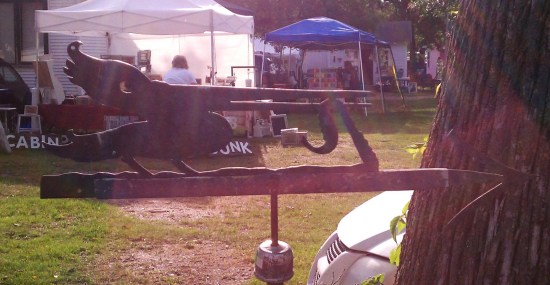Dick and Jane books are among the most popularly collected school books. This is because the series of books was used for over 40 years in American schools. That’s millions of children who were taught by Dick, Jane, Sally, Pam, Penny, Mike, their neighbors, families, and pets! Here’s a bit of history on the vintage Dick and Jane series of books.

In the late 1920s, Zerna Addis Sharp sought out William S. Gray, a renowned educational psychologist and reading authority from the University of Chicago, and pitched to him her philosophy that children are more receptive to reading if the books contained illustrations related to them and their lives. Gray was impressed enough to hire Sharp. While illustrations of the family Sharp created were published in earlier versions of primers by Scott, Foresman and Company, it wasn’t until later that Dick and Jane would appear by name.
In 1930, Gray and William H. Elson, along with May Hill Arbuthnot, created the Curriculum Foundation Series of books for Scott, Foresman and Company. Here Dick & Jane and their family appeared in the first edition of the Curriculum Foundation Series pre-primer called Elson Basic Readers. In this edition, the baby sister was not named yet (she was simply called “Baby”), the cat was called “Little Mew”, and Spot, the dog, was a terrier.

In 1934, the pre-primer was renamed Dick and Jane and a second book, also a pre-primer, More Dick and Jane Stories, was added. In 1936, the series title changed to Elson-Gray Basic Readers to acknowledge Gray’s role in the series (Sharp was not acknowledged, despite what would be a 30 year career at Scott, Foresman & Company). Eleanor Campbell and Keith Ward did the illustrations, and Marion Monroe also authored some of these early editions of the Dick and Jane books.
Scott, Foresman and Co. retired the Elson-Gray series in 1940, but Dick and Jane remained in the Basic Readers and their Think-and-Do workbooks. Now the baby sister is named Sally — and she gets a teddy bear named Tim, the cat becomes Puff, and Spot becomes a Cocker Spaniel. New books in the series were introduced in 1940 and 1946. In Canada, English and French versions of the Dick and Jane books were translated and published by W.J. Gage & Co., Limited; and British English versions were published by Wheaton in Exidir in the UK. Official Catholic editions of the series, the Cathedral Basic Readers, were created to teach religious themes along with reading. For example, Sally, Dick, and Jane was retitled Judy, John, and Jean to reflect Catholic Saints and to include stories on morality. In the 1946 edition, Tim the teddy was removed and a toy duck was added. Also, Texas had its own editions of the the books in 1946. Another author, A. Sterl Artley, began writing Dick and Jane books in 1947. By the end of the 1940s, the Collection Cathedral was published for French-Canadian Catholics.

By the 1950’s, over 80% of first-graders in the United States were learning to read with Dick and Jane. New editions whose titles began with “The New” were added, and Robert Childress would become the illustrator. But it was during this decade that Dick and Jane et al. would find themselves under strong attack. Concerned groups criticized everything from misrepresentations of perfection and other cultural issues to matters of literacy itself. In 1955’s Why Johnny Can’t Read, Rudolf Flesch blamed the look-say style of Dick and Jane readers for not properly teaching children how to read or appreciate literature. While phonetics were always a part of the Dick and Jane series, there was not enough for the growing movement of phonics fans. For all of these reasons, most of the major changes to the Dick and Jane series occurred in the 1960s.

In 1962, Helen M. Robinson was the new head author, the books had new material (including more phonics), new illustrations by Richard Wiley, and Dick and Jane had matured, in age and sophisticated. The initial printings of the 1962 soft-cover Dick and Jane books increased in page size and did not have the white tape reinforcement on the spine. The covers of these editions fell off rather easily — which is why they are so hard to find with covers intact. As a result, Scott, Foresman and Company added the reinforced taped spines and advertised the feature heavily. (These books were never issued as hardcovers; any hardcover copies were either library bindings or were rebound later.)

But in 1965, both Civil Rights school integration and President Lyndon B. Johnson’s Elementary and Secondary Education Act would continue to challenge the book publisher.
Scott, Foresman and Company worked to address the school integration and inclusion issues by once again employing Zerna Sharp’s literacy philosophy. The African-American family, including twins Pam and Penny and their brother Mike, first appeared in the 1964 Catholic School books; public school students were introduced to the African-American family in 1965. (In response to outrage from racist complaints, Scott, Foresman & Company offered alternative covers of the 1965 integrated books; these Child Art editions removed the characters from the covers and replaced them with finger-paint art designs. Later editions of Think and Do books just had solid color blocks.) Also in 1965, the Pacific Press Publishing Association published an integrated version of Fun With Dick and Jane for Seventh-day Adventists. Entitled Friends We Know, Jesus appears on the covers along with Dick, Jane and Mike.

In the mid 1960s, Scott, Foresman and Company tried to address the phonics issue by introducing books in an experimental language called Initial Teaching Alphabet or ITA. The Experimental Edition of the Scott-Foresman pre-primer was titled Nou Wee Reed. These ITA Dick and Jane books are rare finds.
In the late 1960s, the Dick and Jane books expanded to include three new series based on academic performance. For those performing below grade level, there was Open Highways. (Original printings of these books had “The Open Highways Readers” printed on the spine; later printings just had “Open Highways”.) For strong readers, Scott, Foresman and Company added Wide Horizons, self-directed readers which did not have workbooks, and for even more advanced or gifted readers, there was also Bright Horizons. Reading Inventory tests were added to the Dick and Jane series to use as a placement guide.
Despite all Scott, Foresman and Co. tried to do, the book publisher just couldn’t overcome all the objections, especially those regarding the too-perfect Dick and Jane world. The goody-goody kids and their ideal gender stereotyped simplicity was no longer relatable or desirable. The series was officially ended in the late 1960s, replaced in 1970 with Scott, Foresman Reading Systems. (However, in 1975, the 1962 pre-primer was republished by the American Printing House for the Blind in a large type edition with black and white images for sight-impaired children.) Still, Dick and Jane books continued to be ordered and sold from warehouse stock well into the 1970s.
The books Dick and Jane collectors are searching for today are those which managed to be saved — and held onto — by teachers, staff, and students, despite the fact that many schools were even ordered to destroy all remaining copies of works in the series. For these reasons, along with the usual wear and tear of children’s books, finding vintage Dick and Jane books in pristine conditions is very difficult. Collectors learn to live with writings, doodles and marks, missing pages, etc. — or pay steep prices for not having signs of use.
Over the decades, many Dick and Jane materials were produced. Along with the readers and primers mentioned, there were other subject books, such as art, health, math, etc. There were teacher editions; books on teaching techniques; large display books placed on easels, called Our Big Book; posters and picture cut-outs for classroom display; picture and word flash cards; LP record albums; games for the classroom; and other teaching aids.



On the business end, Scott, Foresman and Co. sent out catalogs, newsletters, and promotional items, such as calendars, greeting cards, and Christmas ornaments. These items were produced in much smaller quantities and, being ephemeral in nature, are rare finds.

But Dick and Jane live on.
In 1977, George Segal and Jane Fonda would star in Fun with Dick and Jane, a film based on a Gerald Gaiser story about the failed promises of a Dick and Jane perfect world. (The film was remade with Jim Carrey and Tea Leoni in 2005.)
In 2003, Grosset & Dunlap rereleased original Dick and Jane primers, selling over 2.5 million copies in just over a year even with a publisher disclaimer that the books were nostalgic and not to be used to teach children to read. Due to the popularity of the reissue, reproductions and new related merchandise featuring the iconic imagery and catch phrases, like “See Spot run!”, has been produced.
Additional Resources:
A rather complete list of original Dick and Jane books is here.
Carole Kismaric’s Growing Up with Dick and Jane: Learning and Living the American Dream captures the nostalgia while tracing the cultural points of the Dick and Jane series.
Image Credits:
(In order they appear)
Our Big Book, Dick and Jane Teacher’s Classroom Edition, via into_vintage.
First Dick and Jane book, the 1930 Elson Basic reader, via Tiny Town Books & Toys.
Set of 11 vintage Dick and Jane readers from the 1940s and set of 13 readers from the 1950s, via Wahoos House .
.
The 1963 Judy, John And Jean New Cathedral Basic Reader, via Keller Books.
Set of 13 books from 1960s, via Wahoos House .
.
A set of 1930s Dick and Jane flashcards, via Wahoos House ; vintage Dick and Jane Blackout Game, circa 1950s, and 1951 Poetry Time three-record Dick and Jane set, narrated in the voice of May Hill Arbuthnot one of the original Dick and Jane authors, via Tiny Town Books & Toys.
; vintage Dick and Jane Blackout Game, circa 1950s, and 1951 Poetry Time three-record Dick and Jane set, narrated in the voice of May Hill Arbuthnot one of the original Dick and Jane authors, via Tiny Town Books & Toys.
The 1954 Scott, Foresman and Company Dick and Jane sales catalog, via Tiny Town Books & Toys.








































































































